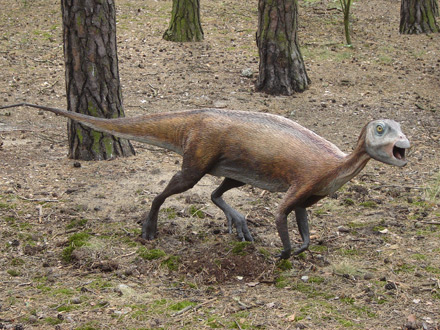
|
Search JoyZine with Google Site Search! |
Atlascopcosaurus
Atlascopcosaurus (meaning "Atlas Copco lizard") is a genus of herbivorous basal dinosaur from the Early Cretaceous of the present Australia. Atlascopcosaurus was one of several small hypsilophodontid dinosaurs that lived in south-eastern Australia, at a time when the rift between Australia and Antarctica was just beginning to open. The type specimen was found in 1984 at the Dinosaur Cove East site at the coast of Victoria, in layers of the Eumeralla Formation dating from the early Cretaceous, Aptian-Albian. This holotype consists of a piece of the upper jaw, a partial maxilla with teeth. Nothing else is known about it; as the rest of the skeleton remains undiscovered it can only be inferred from closely related species that the genus represents a small bipedal herbivore. By extrapolation it has been estimated that it was about 2-3m long and weighed roughly 125k. The type species, Atlascopcosaurus loadsi, was named and described by Tom Rich and Patricia Vickers-Rich in 1988/1989. The generic name refers to the Atlas Copco Company who had provided equipment for the dig that discovered this dinosaur in 1984. The project revealed 85 fossil bone fragments of various species. This opened the door for more excavation and, along with other companies, Atlas Copco helped over ten years excavate about sixty metres of tunnel in a cliff wall at the sea shore. The specific name, loadsi, honours William Loads, the state manager for Atlas Copco at the time, who assisted during the dig. Atlascopcosaurus was in 1988 assigned to the Hypsilophodontidae. These are today seen as an unnatural paraphyletic group and Atlascopcosaurus is now simply considered a basal member of the Euornithopoda. Like other hypsilophodontids, Atlascopcosaurus was an agile bipedal plant-eater. It played an ecological role similar to that of wallabies in the modern world. Its upper teeth were similar to those of Zephyrosaurus, from Montana, USA, but the primary ridge on each of Atlascopcosaurus's teeth was more strongly developed. Zephyrosaurus was also somewhat smaller. Atlascopcosaurus used its high-crowned, many-ridged teeth for browsing on the tough ferns and horsetails that formed the understory of the forests along the rift valley. Like its slightly smaller relatives Leaellynasaura, Fulgurotherium, and Qantasssaurus, Atlascopcosaurus probably lived in family groups or small herds, moving between resting places in deep thickets and open clearings, where it fed on new plant growth. With its long legs and almost hooflike hind claws, this dinosaur could outrun most of its potential predators. An articulated partial skeleton thought to be that of Atlascopcosaurus is remarkable because the left tibia shows severe pathology—evidence that the animal suffered from chronic osteomyelitis for the last few years of its life. The fact that a crippled animal was able to survive for several years suggests that Atlascopcosaurus was not always under intense pressure from predators, and also that it probably did not need to undertake long migrations to avoid the harsh polar winters. |
